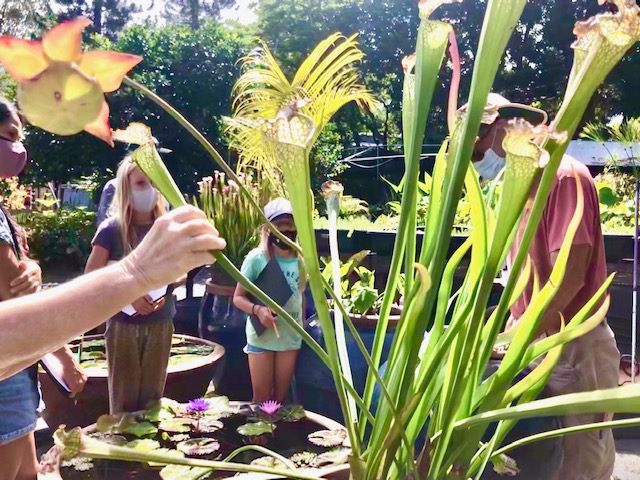Being a water garden nursery, we are always experimenting with plants that grow along the edges of our beloved water gardens. Marginal plants, add vertical interest, color variation, shade, and variety. We have expanded over the years beyond water lilies and bog plants to include carnivorous plants, and more recently, lava rock planters that act as a bold and artful centerpiece. Here are some great choices and tips to help with your winter wish-list, sure to give you joy year-round.
Shade-loving anthurium’s, for example, planted in Featherstone volcanic rock, are a low-maintenance living art piece that can add life and a splash of color to indoor spaces, or shade-loving water gardens. Long lasting blooms rooted into mossy porous rock, bring the raw elements of nature as the focal point. Glossy leaves and flowers are offset by the rough volcanic glass. Delicate roots trellis over and through the piercing sharp rock fragments. These striking planters are an excellent gift to oneself or others.
Carnivorous plants are great to invest in this time of year. Many carnivorous plants go dormant in November – December which is the ideal time to repot and divide tubers. We have just divided north American pitcher plants known as sarracenia Leucophylla, and Flava Flava, giving us plenty of starts that will wake up on their own in the spring.
It is a great joy to watch in wonder as the dormant north American pitcher plants wake up. First, they send out their unusual and beautiful flowers to be pollinated. Once the flower’s petals have drooped and fallen, the plant will begin to send out its pitchers (its ‘mouth’). The reason the flower forms first, is so as not to risk having its own pollinators (bees) become lunch (how considerate!). The pitchers develop and open, working to attract many insects into their pit fall traps – including flies, ants, and wasps. The insects will slip into the cocktail of digestive enzymes and be slowly absorbed by the plant. Carnivorous plants may be ‘fed’ insects, collected, and dropped into their pitchers, blurring the line between plant and ‘pet’.
Tropical pitcher plants are vining plants, known for their vase like pitchers that can get large enough to digest a mouse. We have a nice selection of cuttings available of nepenthes Miranda and a lowland species called nepenthes Gracillis. These plants can be trained to grow in the understory of fruit trees or are quite content in an east or southeast facing window in a hanging basket, so long as its soil remains moist.
If you would like to split or repot your carnivorous plants, we have a suitable soil mixture available for sale at our nursery in Kilauea. We would be happy to offer you advice, based on our own experiences and trials growing carnivorous plants in Hawai’i.
We must not forget to mention the balanced ecosystems and show-stopping water lilies, here at Garden Ponds. We have many lily varieties that bloom year-round in Hawai’i, so be sure to include a water garden featuring a magical water lily on your wish-list.
To find out more, register for Ken Bernard’s upcoming water garden classes as a way to deepen your existing knowledge or to see if water gardening is for you:
Secrets of Water Gardening – Saturday December 4, from 10am-12noon
Waterlily 101– Saturday December 18, from 10am-12noon.
Registration can be found online via Eventbrite HERE.
Garden Ponds is located beside the Kaua’i Mini Golf in Kilauea. We are open Wednesday to Sunday 12-5pm. Call us at 808-828-6400 for more information.

Ken Bernard’s Secrets of Water Gardening Class pauses to observe the north American pitcher plant, s. Leucophylla
